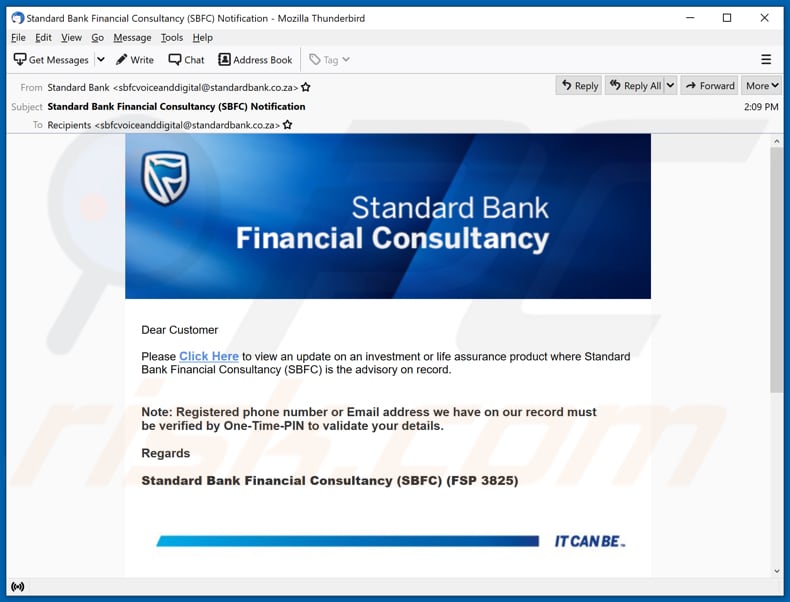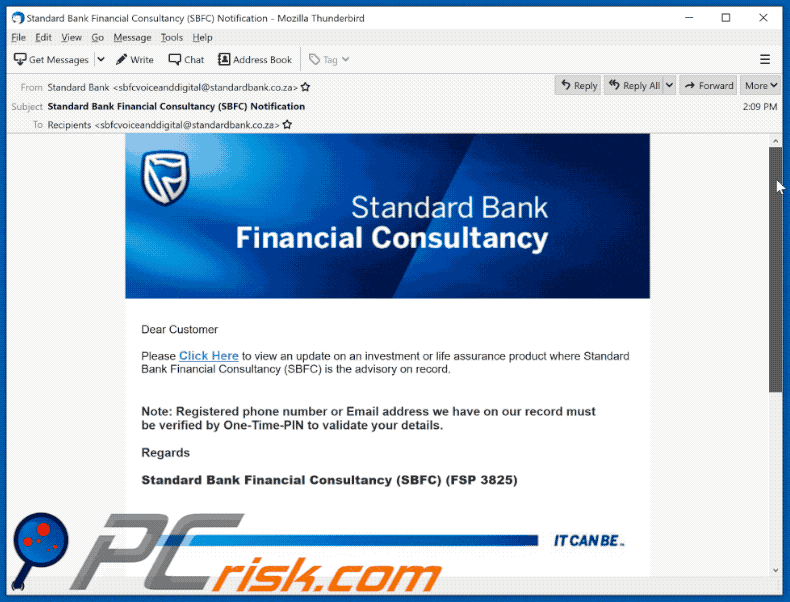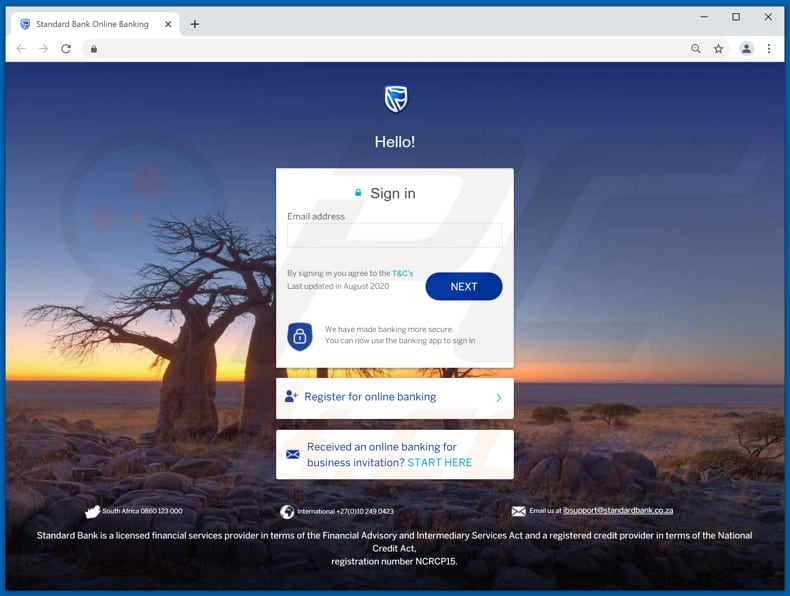Do not trust the Standard Bank Financial Consultancy (SBFC) email scam
Phishing/ScamAlso Known As: Standard Bank Financial Consultancy (SBFC) spam
Get free scan and check if your device is infected.
Remove it nowTo use full-featured product, you have to purchase a license for Combo Cleaner. Seven days free trial available. Combo Cleaner is owned and operated by RCS LT, the parent company of PCRisk.com.
What is Standard Bank Financial Consultancy (SBFC) email scam?
In most cases, phishing emails are designed to look like official, important or urgent letters from legitimate companies, organizations. Scammers send such emails to trick recipients into providing personal, sensitive information.
It is common that they try to obtain information such as credit card details (e.g., cardholder name, CVV code, credit card number), login credentials (e.g., usernames, email addresses, passwords), or other details. This phishing email is disguised as a notification from the Standard Bank Financial Consultancy, an Africa-oriented financial services organization.

Scammers attempt to trick recipients into clicking the provided link that is supposed to open a website where recipients will be able to view and update life assurance contract details. The email also contains a disclaimer and confidentiality note copied from other websites.
The main purpose of this scam is to trick recipients into opening a deceptive website and providing their login credentials (email address and a password) for Standard Bank's online banking account. Typically, scammers use stolen banking accounts to make fraudulent transactions, purchases, or they sell them to third parties (other cybercriminals) on the darkweb/hacker forums.
It is important to mention that stolen login credentials may be used to steal other accounts, it applies to accounts with the same login credentials. Depending on the types of stolen accounts, they could be used to spread spam, deliver malware, extract personal information, money, blackmail other people, or for other malicious purposes.
Phishing emails have to be ignored. Recipients who fall for them lose access to personal accounts, suffer monetary loss, encounter problems related to online privacy and other issues.
| Name | Standard Bank Financial Consultancy (SBFC) Email Scam |
| Threat Type | Phishing, Scam, Social Engineering, Fraud |
| Fake Claim | Recipients can view and update their life assurance contract details |
| Disguise | Notification from Standard Bank |
| Related Domain | abscommunication[.]in |
| Detection Names | Fortinet (Phishing), Webroot (Malicious), Full Detections List (VirusTotal) |
| Symptoms | Unauthorized online purchases, changed online account passwords, identity theft, illegal access of the computer. |
| Distribution methods | Deceptive emails, rogue online pop-up ads, search engine poisoning techniques, misspelled domains. |
| Damage | Loss of sensitive private information, monetary loss, identity theft. |
| Malware Removal (Windows) |
To eliminate possible malware infections, scan your computer with legitimate antivirus software. Our security researchers recommend using Combo Cleaner. Download Combo CleanerTo use full-featured product, you have to purchase a license for Combo Cleaner. 7 days free trial available. Combo Cleaner is owned and operated by RCS LT, the parent company of PCRisk.com. |
More examples of phishing emails that scammers have used (and could be still using) to obtain sensitive information from unsuspecting users are "System Administrator Quota Update Email Scam", "Verify Your Email Account Scam", and "Posteitaliane Email Scam". In most cases, scammers try to trick recipients into providing login credentials for social media, email, banking or other accounts, or credit card details.
It is important to know that email can be used as a channel to deliver malware as well, for example, ransomware, trojan, or other unwanted software like cryptocurrency miner.
How do spam campaigns infect computers?
Usually, emails that cybercriminals send with the purpose to trick recipients into infecting their computers with malware have a malicious file attached to them or include a link designed to open a download page for a malicious file.
Recipients install malware by opening downloaded malicious attachments or files. Typically, cybercriminals use Microsoft Office, PDF documents, JavaScript files, executable files like EXE, archive files like RAR ZIP in their malspam campaigns.
It is noteworthy that malicious documents do not infect computers unless users enable content or editing (macros commands) in them. Although, only when those documents are opened with MS Office 2010 and newer versions.
Any other MS Office version does not have the "Protected View" mode. This mode does not allow malicious documents to install malware as long as macros commands are not enabled by users manually.
How to avoid installation of malware?
Files attached or website links included in irrelevant emails sent from some trustworthy, known address should not be opened. It is very common that cybercriminals use email as a channel to deliver malware.
Files and programs should be downloaded from official websites and via direct download links only. Downloads from unofficial websites, third-party downloaders , Peer-to-Peer networks (e.g., eMule, torrent clients), etc., can be malicious.
The same applies to third-party installers. Installed programs (and the operating system) have to be activated and updated properly. It has do be achieved using tools or implemented functions provided by their official developers.
Typically, unofficial, third-party tools do not activate or update any software - they are bundled with malware. Another reason not to use tools of this type to activate licensed software is that it is against the law.
It is not legal to use pirated software as well. The operating systems should be scanned for unwanted, malicious entries, programs regularly.
It should be done using an up-to-date and reputable antivirus or anti-spyware suite. If you've already opened malicious attachments, we recommend running a scan with Combo Cleaner Antivirus for Windows to automatically eliminate infiltrated malware.
Appearance of the Standard Bank Financial Consultancy (SBFC) email scam:

Text in the email:
Subject: Standard Bank Financial Consultancy (SBFC) Notification
Standard Bank Financial Consultancy
Dear Customer
Please Click Here to view an update on an investment or life assurance product where Standard Bank Financial Consultancy (SBFC) is the advisory on record.
Note: Registered phone number or Email address we have on our record must be verified by One-Time-PIN to validate your details.Regards
Standard Bank Financial Consultancy (SBFC) (FSP 3825)
Standard Bank Financial Consultancy (SBFC) is an Authorised Financial Services Provider (FSP 3825) and a business unit of The Standard Bank of South Africa Limited.The Standard Bank email disclaimer and confidentiality note:
This email, its attachments and any rights attaching hereto are, unless the context clearly indicates otherwise, the property of the
Standard Bank Group Limited and/or its subsidiaries ("the group"). It is confidential, private and intended for the addressee only.Should you not be the addressee and receive this email by mistake, kindly notify the sender, and delete it immediately. Do not
disclose or use the email in any manner whatsoever.Views and opinions expressed in this email are those of the sender unless clearly stated as those of the group.
The group accepts no liability whatsoever for any loss or damages - whatsoever and howsoever incurred - or suffered resulting or
arising from the use of this email or its attachments. The group does not warrant the integrity of this email nor that it is free of
errors, viruses, interception or interference.The group will never send you any email or other communication asking you to update or provide confidential information about you or your account. If you have any doubts about the legitimacy of this email or other emails you receive claiming to be from Standard Bank please forward them to phishing@standardbank.co.za
For more information about Standard Bank Group Limited see www.standardbank[.]com
Should you wish to unsubscribe, please send an email to: Unsubscribe@standardbank.co.za
Moving Forward is a trademark of The Standard Bank of South Africa Limited.
Screenshot of the fake Standard Bank login page:

Instant automatic malware removal:
Manual threat removal might be a lengthy and complicated process that requires advanced IT skills. Combo Cleaner is a professional automatic malware removal tool that is recommended to get rid of malware. Download it by clicking the button below:
DOWNLOAD Combo CleanerBy downloading any software listed on this website you agree to our Privacy Policy and Terms of Use. To use full-featured product, you have to purchase a license for Combo Cleaner. 7 days free trial available. Combo Cleaner is owned and operated by RCS LT, the parent company of PCRisk.com.
Quick menu:
- What is Standard Bank Financial Consultancy (SBFC) spam?
- Types of malicious emails.
- How to spot a malicious email?
- What to do if you fell for an email scam?
Types of malicious emails:
![]() Phishing Emails
Phishing Emails
Most commonly, cybercriminals use deceptive emails to trick Internet users into giving away their sensitive private information, for example, login information for various online services, email accounts, or online banking information.
Such attacks are called phishing. In a phishing attack, cybercriminals usually send an email message with some popular service logo (for example, Microsoft, DHL, Amazon, Netflix), create urgency (wrong shipping address, expired password, etc.), and place a link which they hope their potential victims will click on.
After clicking the link presented in such email message, victims are redirected to a fake website that looks identical or extremely similar to the original one. Victims are then asked to enter their password, credit card details, or some other information that gets stolen by cybercriminals.
![]() Emails with Malicious Attachments
Emails with Malicious Attachments
Another popular attack vector is email spam with malicious attachments that infect users' computers with malware. Malicious attachments usually carry trojans that are capable of stealing passwords, banking information, and other sensitive information.
In such attacks, cybercriminals' main goal is to trick their potential victims into opening an infected email attachment. To achieve this goal, email messages usually talk about recently received invoices, faxes, or voice messages.
If a potential victim falls for the lure and opens the attachment, their computers get infected, and cybercriminals can collect a lot of sensitive information.
While it's a more complicated method to steal personal information (spam filters and antivirus programs usually detect such attempts), if successful, cybercriminals can get a much wider array of data and can collect information for a long period of time.
![]() Sextortion Emails
Sextortion Emails
This is a type of phishing. In this case, users receive an email claiming that a cybercriminal could access the webcam of the potential victim and has a video recording of one's masturbation.
To get rid of the video, victims are asked to pay a ransom (usually using Bitcoin or another cryptocurrency). Nevertheless, all of these claims are false - users who receive such emails should ignore and delete them.
How to spot a malicious email?
While cyber criminals try to make their lure emails look trustworthy, here are some things that you should look for when trying to spot a phishing email:
- Check the sender's ("from") email address: Hover your mouse over the "from" address and check if it's legitimate. For example, if you received an email from Microsoft, be sure to check if the email address is @microsoft.com and not something suspicious like @m1crosoft.com, @microsfot.com, @account-security-noreply.com, etc.
- Check for generic greetings: If the greeting in the email is "Dear user", "Dear @youremail.com", "Dear valued customer", this should raise suspiciousness. Most commonly, companies call you by your name. Lack of this information could signal a phishing attempt.
- Check the links in the email: Hover your mouse over the link presented in the email, if the link that appears seems suspicious, don't click it. For example, if you received an email from Microsoft and the link in the email shows that it will go to firebasestorage.googleapis.com/v0... you shouldn't trust it. It's best not to click any links in the emails but to visit the company website that sent you the email in the first place.
- Don't blindly trust email attachments: Most commonly, legitimate companies will ask you to log in to their website and to view any documents there; if you received an email with an attachment, it's a good idea to scan it with an antivirus application. Infected email attachments are a common attack vector used by cybercriminals.
To minimise the risk of opening phishing and malicious emails we recommend using Combo Cleaner Antivirus for Windows.
Example of a spam email:

What to do if you fell for an email scam?
- If you clicked on a link in a phishing email and entered your password - be sure to change your password as soon as possible. Usually, cybercriminals collect stolen credentials and then sell them to other groups that use them for malicious purposes. If you change your password in a timely manner, there's a chance that criminals won't have enough time to do any damage.
- If you entered your credit card information - contact your bank as soon as possible and explain the situation. There's a good chance that you will need to cancel your compromised credit card and get a new one.
- If you see any signs of identity theft - you should immediately contact the Federal Trade Commission. This institution will collect information about your situation and create a personal recovery plan.
- If you opened a malicious attachment - your computer is probably infected, you should scan it with a reputable antivirus application. For this purpose, we recommend using Combo Cleaner Antivirus for Windows.
- Help other Internet users - report phishing emails to Anti-Phishing Working Group, FBI’s Internet Crime Complaint Center, National Fraud Information Center and U.S. Department of Justice.
Share:

Tomas Meskauskas
Expert security researcher, professional malware analyst
I am passionate about computer security and technology. I have an experience of over 10 years working in various companies related to computer technical issue solving and Internet security. I have been working as an author and editor for pcrisk.com since 2010. Follow me on Twitter and LinkedIn to stay informed about the latest online security threats.
PCrisk security portal is brought by a company RCS LT.
Joined forces of security researchers help educate computer users about the latest online security threats. More information about the company RCS LT.
Our malware removal guides are free. However, if you want to support us you can send us a donation.
DonatePCrisk security portal is brought by a company RCS LT.
Joined forces of security researchers help educate computer users about the latest online security threats. More information about the company RCS LT.
Our malware removal guides are free. However, if you want to support us you can send us a donation.
Donate
▼ Show Discussion